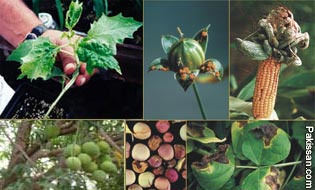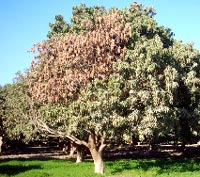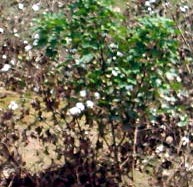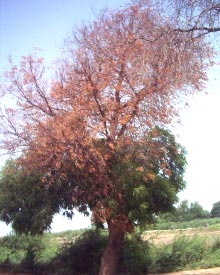Wilt: The most common and destructive disease of crops
By M.
Mithal Jiskani
Assistant Professor (Plant Pathology)
Sindh Agriculture University Tandojam
 Wilt
is the loss of rigidity and dropping of plant parts
(partially or wholly). It is one of the most common and
destructive disease of many field, vegetable and fruit
crops, also attack on many species of wild plants and
trees. In Pakistan, wilt is reported on 28 different
crops, including Cotton, Rape seed and Mustard,
Groundnut, Linseed, Sunflower, Safflower, Gram, Mung
bean, Moth, Mash, Lentil, Pea, Guar, Potato, Chilies,
Tomato, Cucurbits (vine crops e.g. melons, cucumber
etc.), Citrus (orange, lemon etc.), Banana and Guava
(Table 1). Now a day, the symptoms similar to wilt
disease are also occurring in wheat, maize, sugarcane,
sesame, castor, soybean, pigeon pea, mango and papaya. Wilt
is the loss of rigidity and dropping of plant parts
(partially or wholly). It is one of the most common and
destructive disease of many field, vegetable and fruit
crops, also attack on many species of wild plants and
trees. In Pakistan, wilt is reported on 28 different
crops, including Cotton, Rape seed and Mustard,
Groundnut, Linseed, Sunflower, Safflower, Gram, Mung
bean, Moth, Mash, Lentil, Pea, Guar, Potato, Chilies,
Tomato, Cucurbits (vine crops e.g. melons, cucumber
etc.), Citrus (orange, lemon etc.), Banana and Guava
(Table 1). Now a day, the symptoms similar to wilt
disease are also occurring in wheat, maize, sugarcane,
sesame, castor, soybean, pigeon pea, mango and papaya.
The wilt appears most commonly every year in the fields
if once occurred and crops are sown repeatedly without
rotation, and hence it causes considerable losses in
every cropping season. The most of the growers are near
about unaware to the problem, therefore the symptoms,
perpetuation, preventive and curative control measures
are given for their guidance as well as just reminder to
the researchers and extension workers, with a hope that
all the concerned will think about the issue and try to
find out the most easy and economical ways to combat
wilt diseases. It is also expected from the breeders
that they will work more on only the safe solution of
problem, i.e. developing and introducing resistant
varieties.
 The
wilt diseases may be caused by fungi, viruses,
nematodes, parasitic flowering plants and insects. These
are usually confused with root and crown rots, stem
cankers, insect injuries, drought or excess water, soil
compaction, and other non-infectious problems. The wilts
caused by other than fungi have no economic importance
in Pakistan, but the bacterial wilt, caused by Ralstonia
solanacearum is now become important one after fungal
wilts. According to Ahmed and Burney (2nd International
Bacterial Wilt Symposium, 22-27 June, 1997), bacterial
wilt was first reported in 1968 in the potato growing
areas of Punjab, Pakistan. They stated that, the
prevalence and incidence of this disease on other crops
in Pakistan were lacking, but recent surveys of potato,
tomato and chili growing areas reveal that the pathogen
is present in all the four provinces of Pakistan. They
also reported disease incidence in tomatoes and chilies,
and isolated and identified the bacterial wilt pathogen
from diseased peanut, beans and sunflower plants.
However, the extent of damage due to the bacterial wilt
on these hosts has not been documented. The
wilt diseases may be caused by fungi, viruses,
nematodes, parasitic flowering plants and insects. These
are usually confused with root and crown rots, stem
cankers, insect injuries, drought or excess water, soil
compaction, and other non-infectious problems. The wilts
caused by other than fungi have no economic importance
in Pakistan, but the bacterial wilt, caused by Ralstonia
solanacearum is now become important one after fungal
wilts. According to Ahmed and Burney (2nd International
Bacterial Wilt Symposium, 22-27 June, 1997), bacterial
wilt was first reported in 1968 in the potato growing
areas of Punjab, Pakistan. They stated that, the
prevalence and incidence of this disease on other crops
in Pakistan were lacking, but recent surveys of potato,
tomato and chili growing areas reveal that the pathogen
is present in all the four provinces of Pakistan. They
also reported disease incidence in tomatoes and chilies,
and isolated and identified the bacterial wilt pathogen
from diseased peanut, beans and sunflower plants.
However, the extent of damage due to the bacterial wilt
on these hosts has not been documented.
 The
most common and destructive wilt diseases are caused by
several species of Fusarium and Verticillium fungi,
their common names are referred to causal fungus such as
Fusarium or Verticillium wilt. Both the fungi differ
from one another, but cause very similar symptoms. The
only reliable method for separating and identifying
these diseases is taxonomy of causal fungi, both can be
readily isolated from the diseased plant portions and
cultured. Both the fungal wilts thrive with high
nitrogen fertilizer, excessive soil moisture, thin
stands, and deep cultivation during the growing season.
Both the fungi survive for long periods (for at least a
decade) in soil on organic matter and even on non-host
plant. However, some of the differential general
characteristics between both the wilt fungi may also
help in identification and control (Table 2). The
most common and destructive wilt diseases are caused by
several species of Fusarium and Verticillium fungi,
their common names are referred to causal fungus such as
Fusarium or Verticillium wilt. Both the fungi differ
from one another, but cause very similar symptoms. The
only reliable method for separating and identifying
these diseases is taxonomy of causal fungi, both can be
readily isolated from the diseased plant portions and
cultured. Both the fungal wilts thrive with high
nitrogen fertilizer, excessive soil moisture, thin
stands, and deep cultivation during the growing season.
Both the fungi survive for long periods (for at least a
decade) in soil on organic matter and even on non-host
plant. However, some of the differential general
characteristics between both the wilt fungi may also
help in identification and control (Table 2).
|
Table 2:
Differential general characteristics
between Fusarium and
Verticillium spp. |
|
Fusarium wilt |
Verticillium wilt |
|
grows
best in acid soils |
thrives
in alkaline soil |
|
more
prevalent in sandy soil |
more
prevalent in heavy soils |
|
causes
more injury when root-knot, reniform or
sting nematodes injure the roots |
does not
require injury for infection |
|
can be
transmitted internally in seed |
can not
be transmitted internally in seed |
|
prefers
hotter soil than Verticillium |
prefers
cooler soil than Fusarium |
|
The Fusarium spp. are
predominantly common soil fungi, found in almost all
parts of the world as a not-detrimental colonizer of
root surfaces or a weak invader of the root cortex of
many plants. There are over 80 known strains only of F.
oxysporum, which show specific pathogenicity to
particular crops, causing the vascular wilt diseases.
Mirza and Qureshi (1978) found that most of root
infecting fungi including Fusarium spp. are known to
attack many cultivated plants and parasitized 36 hosts
in Pakistan. The cotton husks, used as cattle feed are
identified as a potential source for spread of wilt
causing fungus (F. oxysporum f. sp. vasinfectum).
In addition, both the pathogens (Fusarium and
Verticillium spp.) are seed-borne, may carry over for
long-distance, spread from year to year by sowing
infected seed; also move from field to field, farm to
farm and region to region, whenever very small
quantities of infested soil is transported through
boots, farm equipments, vehicles, in water (irrigation
and overland flows), in flood irrigation and also in
infected plant material, including seed etc. The
diseased plant debris lying in the field or in the
threshing area also helps both the fungi to remain
alive. In case of banana, Fusarium wilt or Panama
disease is considered the worlds worst disease and the
greatest danger of its spread comes from moving infected
suckers (planting material, look like healthy on the
outside).
 The
wilts start appearance at seedling in case of early
attack and/or may also occur at any plant growth stage.
Symptoms include seed rot, seedling death and wilting,
and death of adult plants. Initially, vein clearing and
leaves show a distinct loss of turgor and yellowing
occurs starting at the leaf margin between the main
veins, sometimes referred as leaf epinasty, followed by
stunting. The stunted plants may fruit early. The
yellowing progresses inward and is followed by necrosis
hence defoliation occurs starting at the bottom of the
plant, and working towards the top, results progressive
wilting of leaves and stem, defoliation and finally
death of the plant (partially or wholly). The diseased
plants are pulled out easily, due to the loss of
rigidity. Brown, red or yellow rings of discolored
tissue observed in case of cutting the stem in
crossways, mostly close to the base. Fusarium wilt is a
solid dark brown ring around the outer portion of the
stem, in cross section in the area of the vascular
bundles, and that the infected areas observed irregular
in shape and size. The wilt diseases mostly spread in
patches, but entire field may also be affected in severe
conditions. Some formae speciales are not primarily
vascular pathogens but Fusarium spp. may cause foot and
root rot or bulb rot in cotton. The
wilts start appearance at seedling in case of early
attack and/or may also occur at any plant growth stage.
Symptoms include seed rot, seedling death and wilting,
and death of adult plants. Initially, vein clearing and
leaves show a distinct loss of turgor and yellowing
occurs starting at the leaf margin between the main
veins, sometimes referred as leaf epinasty, followed by
stunting. The stunted plants may fruit early. The
yellowing progresses inward and is followed by necrosis
hence defoliation occurs starting at the bottom of the
plant, and working towards the top, results progressive
wilting of leaves and stem, defoliation and finally
death of the plant (partially or wholly). The diseased
plants are pulled out easily, due to the loss of
rigidity. Brown, red or yellow rings of discolored
tissue observed in case of cutting the stem in
crossways, mostly close to the base. Fusarium wilt is a
solid dark brown ring around the outer portion of the
stem, in cross section in the area of the vascular
bundles, and that the infected areas observed irregular
in shape and size. The wilt diseases mostly spread in
patches, but entire field may also be affected in severe
conditions. Some formae speciales are not primarily
vascular pathogens but Fusarium spp. may cause foot and
root rot or bulb rot in cotton.
Preventive and
curative control measures
Prevention is better than cure, because control of wilt
diseases is very difficult, chemical control is very
costly and even is impossible to recover heavily
infected, shriveled and damaged plant. However,
cultivation of resistant variety is only the most easy,
economical and safe method. Growers are advised to plant
improved immune or resistant varieties, because these
are equal to the susceptible varieties in yield,
adaptation and other cultural characteristics and field
practices; since new races of the fungi may develop and
attack on these. However, it is necessary that growers
must keep in touch with the latest information on
resistant varieties and control measures. The following
preventive measures also help to minimize risk of
damage.
Avoid cultivation of susceptible varieties/cultivars
in the diseased area at least for three years.
Clean cultivation through deep and repeatedly tillage
operations help to destroy infected plant parts from
field.
Good drainage improves soil conditions which help to
minimize the disease incidence.
Use of disease free seed or seed treatment with
suitable seed dressing fungicides before sowing is also
recommended.
In some cases, late and deep sowing reduces disease
incidence.
Mixed cropping of with non host crops help to check
the disease.
Uprooting and burning of diseased plants minimize
further spread of the problem.
Avoid storage of plant waste material and even
threshing in the field, otherwise sweeping the threshing
floor and burning or burying all plant debris must be
ensured.
|
Table 1: Crops affected by wilt
causing fungi in Pakistan |
|
Crops |
Disease |
Fungus involved dominantly |
|
Cotton |
Wilt |
Fusarium
oxysporum f. sp.
vasinfectum and Verticillium
spp. |
|
Seed, seedling, foot or root rot &
boll rot |
Fusarium
spp. |
|
Wheat |
Foot
rot, head blight & black point
complex |
Fusarium
spp. |
|
Seed
infection |
F. equiseti and F. moniliforme |
|
Rice |
Associated with seed |
F. equiseti, F. moniliforme, F. semitectum and F. graminearum |
|
Maize, Barley & Sorghum |
Stalk rot & seed infection |
F. moniliforme and F. semitectum |
|
Sorghum |
Grain mold |
Fusarium
spp. |
|
Sugarcane |
Pokkah boeng |
F. moniliforme |
|
Rape
seed & Mustard |
Wilt
and root rot |
Fusarium
spp. |
|
Groundnut |
Wilt
and root rot |
F. coerulium & its other species |
|
Sesamum |
Wilt, stem & root rot |
Fusarium
spp. |
|
Linseed |
Wilt, root rot & seed infection |
Fusarium lini, F. solani and F. moniliforme |
|
Sunflower |
Wilt
and root rot |
Verticillium dahlae |
|
Safflower |
Wilt
and root rot |
Sclerotinia sclerotiorum |
|
Gram/Chickpea |
Wilt, blight, seed and root rot |
F. orthoceros var ciceri, F. solani, F. moniliforme and F.
equiseti and Verticillium
albo-atrum |
|
Mung,
Moth, Mash, potato & tomato |
Wilt
and root rot |
F. solani
and other species of Fusarium |
|
Lentil |
Wilt
and root rot |
F. oxysporum f. sp. lentis and F. solani |
|
Seedling rot |
F. moniliforme and Verticillium spp. |
|
Pea |
Wilt |
F. oxysporum f. sp. pisi |
|
Guar |
Wilt
and root rot |
F. solani,
F. semitectum and F.
redicola |
|
Potato |
Wilt, root or dry tuber rot |
F. oxysporum, F. redicola, F. angustum and F. solani
|
|
Chilies |
Damping off, wilt and root rot |
Fusarium
spp. |
|
Tomato |
Wilt, root rot and damping off |
F. oxysporum f. sp. lycopersici and F. solani |
|
Cucurbits e.g. melons, gourds etc. |
Wilt
and root rot |
Fusarium
spp. |
|
Coriander |
Seed
infection |
F. moniliforme |
|
Citrus e.g. orange, lemon etc. |
Wilt
and root rot |
F. solani
and other species of Fusarium |
|
Banana |
Wilt/ Panama disease |
F. oxysporum
and F. moniliforme |
|
Mango |
Wilt
and root rot |
Fusarium
spp. |
|
Malformation |
F. equiseti, F. moniliforme and other species of Fusarium |
|
Apple |
Wilt
and root rot |
F. solani |
|
Guava |
Wilt
and root rot |
F. solani
and other species of Fusarium |
|
Shisham |
Wilt
and root rot |
Fusarium
and Verticillium spp. |
|
Forest trees |
Wilt
and root rot |
F. oxysporum, F. solani and other species of Fusarium and Verticillium |
|
|
|
Pakissan.com;
|